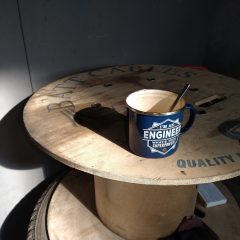I was testing a compact SUV the other day, it’s spec sheet fits in nicely with the current competition; about 240bhp in a 1400kg car, 4WD and 0-60 in the region of 7.9s. Although this may not be earth shattering performance by modern standards it set me thinking, about two decades ago I was working on a car that some of you may of heard of; the Escort Cosworth.
Now the Cossy set the world alight with its ‘blistering performance’, even that bloke Clarkson had one of his own and spent far too long telling everyone. Part of the Cossy legend comes fro the fact that in full rally cross tune it could hit the dark side of 600bhp, but even the standard version was in reality rather quick.
But now the Focus five pot has more than 300bhp and luxury saloons must have 500bhp to be a serious contender. Things have clearly moved on, but surely an old quick car is still a quick car? If I hopped into a Cossy today would I be bored rigid with it’s hum drum performance?
So I did a highly un-scientific poll on Twitter, asking people what felt quick to them, and the results were remarkably consistent, although that might just be an indication of the type of people who follow me!
Allegro fan extraordinare @OneCarefulOwner commented “the goalposts have moved in a major way; my Maxi 1750HL had a blistering 96bhp, nowadays small diesels have more grunt.”
@racing_waiting pointed out that defining quick was a well trodden path “tricky question, drivers republic struggled, imotor struggled, road my previous mag stuggled.”
On the subject of the old XR3i @HairyCalahan observed “times have changed. expectations too. xr3i fine for it’s day”
But getting down to numbers @vHenryk considdered that “pretty much. A ‘sports car’ doesn’t have to be a ridiculously expensive 0-60 in less than 5 secs thing to deserve the name.”. Whilst @torquespeak said “Puma convinces me anything above 120 has a decent shot. 8 secs to 60 not first degree rapid but a hoot on the twisty bits!”
Of course power and weight are only part of the storey as student and car nut @MrPA sugests “On a decent road anything can be fun. I have a few corner-filled favourites which are brilliant in my mum’s 1.2 Clio (75bhp!).” a fair point and one echoed by @cotswoldracer “Indeed , my old AX GT 700Kg & 85bhp , and going by memory about the same as my 145 in terms of acceleration (8ish secs to 60), my Alfa 145/950kg/150bhp quick-ish , another 35 bhp would make it even more fun :)”
@carpunk observes the importance of weight in its own right “Guess 100hp in a 1000kg car will always feel much quicker than 250hp in car 2x the weight because of inertia, braking mass etc “ and @jonbradbury agrees “I think modern expectations have increased, & so has most weights. Though 160hp in 1T 944 shifted lot better 115hp Gti & the 115hp GTi shifted better than the 115hp XR3i.”
The consensus seemed to be that a ‘sports car’ of between 1 and 1.5 tons should have between 180 and 250bhp.
Which brings up some interesting points, firstly that a lot of ordinary family cars are actually high performance sports cars, and it may well be that the only reason that they are not regularly parked in hedges and Armco is the astonishing amount of technology dedicated to combating incompetence behind the wheel.
But going back the that point about the way cars feel, this fantastic driver assistance seems to have come hand in hand with a duller edge to the driving experience. Back in the day a sports car would engage and entertain the driver, not only with its performance but also with its ability to snap back and slap the unwary in the startled face. Putting your foot down in a high powered car not only thrilled but also surprised many a driver when glancing at the speedo to see the needle significantly further round than expected. Over enthusiastic cornering could result in the car suddenly swapping ends or having less wheels on the ground than is healthy. Motoring enthusiasts call this sort of thing ‘fun’, but unfortunately normal people call it dangerous, and so because there are more of ‘them’ buying cars than there are ‘us’ cars have become less dangerous, and sometimes less fun.
But from an engineering point of view fun and safe can co-exist. Some manufacturers have cottoned on to the fact that whilst safe and dull is best for the mass market there is still a significant market for thrilling cars, and having driver aids set to only come in when disaster is otherwise inevitable yet allowing a reasonable degree of sideways progress makes good sense.
For instance if you turn off the traction control on a Jaguar XKR you can light up the tyres and do doughnuts, but you will still struggle to accidentally oversteer backwards into the vicars rose garden because the system is still active and helping the driver achieve their intended trajectory. I have driven one with the traction control completely removed, and to say one needs ones wits honed and ready for extreme service is an understatement, it’s not fun on a wet B road – it’s simply scary.
Maybe 500bhp is fine when controlled by modern electro-wizardry, but has the same thrill factor as a raw 200bhp in a car with no aids at all. So how much power does a sports car need? Well it would seem the definitive answer is ‘it depends’.
